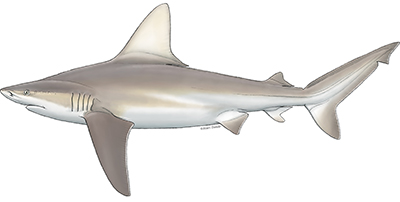Sandbar Shark
Carcharhinus plumbeus

The most common large shark of the U.S. mid-Atlantic coastline. Adolescents and adults use Virginia coastal waters as a summer feeding ground, and Chesapeake Bay is one of the major nursery grounds in the Northwest Atlantic for juveniles.
Maximum Size
8 feet (2.5 meters) total length for females and 5.9 feet (1.8 m) total length for males.
Range
Coastal areas of all tropical and warm temperate oceans and seas.
Diet
Primarily small bottom fishes, mollusks, and crustaceans.
Depth Range
Demersal (bottom-dwelling) sharks typically found over muddy or sandy bottoms from the intertidal zone to waters over 655 feet (200 meters) deep.
Ecology
Migrate seasonally, heading south for the winter and north for the summer. Found in Chesapeake Bay and Virginia waters in the summer and fall. The Bay is one of the most important sandbar shark nursery areas in the western Atlantic. About 8 young comprise a litter of pups that are born at ~ 20 inches (55 cm). The species grows very slowly and does not mature until it is about 25 years old. Maximum age is unknown, but may exceed 50 years.
Fishing Interest
The sandbar shark is often caught by recreational anglers, and is a primary species taken in the commercial fishery. The meat is very good, and sale of its very large fins for shark-fin soup is a major reason for its commercial value.
Abundance
Data from the VIMS Shark Survey show that sandbar sharks were reduced 65% by overfishing from the late 1970s to the early 1990s. The implementation of shark-management measures in Virginia in 1990, and by the federal government in 1993, have led to a slow but steady recovery in their population.

